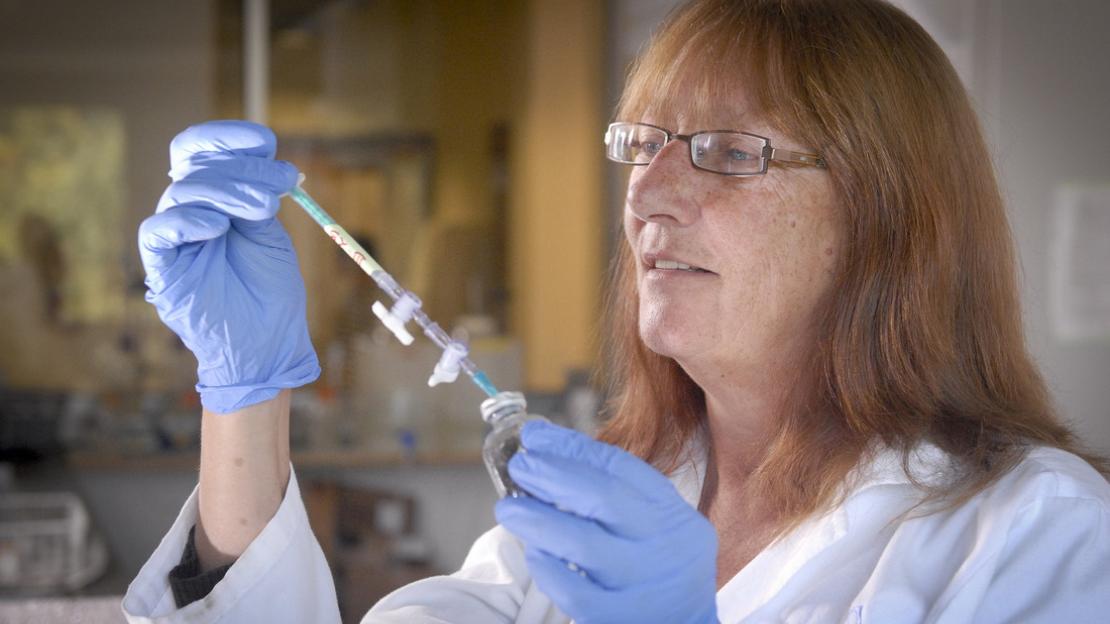Often the public see bacteria as mere agents of disease. But according to University of Toronto of Scarborough Professor Roberta Fulthorpe, the vast majority should be viewed as beneficial.
Fulthorpe, a microbial ecologist, first joined the Department of Physical and Environmental Sciences (DPES) in 1994. From 2010 to 2017, she led the DPES Environmental Science graduate programs – first as Associate Graduate Chair for two years, then as Graduate Chair for five years.
Her early research focused on the biodegradation of toxic man-made compounds in the environment. Her more recent research has focused on the way bacteria interact with plants and live inside plant tissues.
Fulthorpe, who is also cross-appointed with the Department of Biological Sciences, says we are just now beginning to understand that bacteria have many positive interactions with plants, partially through contaminant degradation, a process where toxic chemicals are broken down by internally dwelling bacteria called endophytes.
A 2007 paper co-authored by Fulthorpe is the top cited article in the International Society for Microbial Ecology Journal (ISME), which is the most prestigious in the field of microbial ecology. The research presented findings on how many bacteria are found in soil from four different regions around the world.
Writer, Raquel Russell spoke with Fulthorpe about her ISME paper, her current research projects, and what motivated her to study microbial ecology in the first place.
Your ISME paper has received nearly 900 citations and remains the journal’s top cited paper. Why did you choose to pursue this topic at the time?
While on a sabbatical research break I went down to visit Eric Triplett, who would also co-author the paper, to learn about how to work with bacteria and plants. Eric had bought a 454 sequencer (a trade name for a machine that does next generation DNA sequencing).
During that year, the 454 was at the forefront of technology to take DNA from any sample and generate a million sequences in just a day. With that amount of sequencing power, we asked, what important questions can we answer?
Microbial ecologists have long wondered how many bacterial species are present in a gram of soil. The estimate from an older technique back in 1991 was that there were 4,000 bacteria per gram of soil - and at the time people thought that was astounding.
Earlier in 2005, a colleague of mine had published a paper in which they had reworked the original data and argued that there were one million, not 4,000. So, I said to Eric, these people are disagreeing with each other, but the 454 gives us the capability of advancing that question. So he and I and Luiz Roesch (a PhD candidate working in the lab at the time) took samples from different places, extracted them and ran them through the sequencing procedures. We came up with a number more like 50,000. So not 4,000, not a million, but 50,000.
Why do you think it has received so much attention?
The truth here is that it was a matter of just using a technology first to answer a fundamental question. It shed light on just how much bacterial diversity exists in something common like the soil.
What are some current projects you’re working on?
There are large plots of land over in Oil Springs, Ontario where crude oil deposits lie close to the surface – so close they have been forming patches of “gum” or tar on the soil surface for hundreds of years or more. It is the site of Ontario’s first oil drills and commercial production of hydrocarbon products. The Fairbank family are still drilling there with old fashioned technology. They are producing and occasionally spilling oil adding to very high concentrations of oil components and gasoline in the air all the time.
And yet the plants that grow there in those fields, even right on top of the pump head spills, look perfectly healthy. Plants are growing and flowering and bees are buzzing around. It’s like there is no problem. And yet if you take seeds from elsewhere and plant them into such oil contaminated soils, they just die, but the Oil Springs plants appear totally well adapted to hydrocarbons. You can see stems of golden rod, sweet peas, wild carrots and more coming straight of what appears to be this deep black soil. It’s like an oil slick. Their roots are virtually in pure oil.
So I first thought, as a microbiologist, maybe bacteria living in partnership with these plants are helping them to degrade the contamination. If we can isolate efficient oil degrading bacteria from these highly adapted plants -, maybe we can transfer them to other plants that can help to clean up the soil around pipe line spills, old gas stations and other contaminated sites. Phytoremediation, using plants and their bacteria to clean up contaminated soils, that’s the ultimate application.
Why should students choose microbiology?
Environmental microbiology is a frontier for science, because of the new sequencing capabilities, we’re really only beginning to glimpse what level of bacterial diversity truly exists out there in the environment. We’ve always known that microbial processes are extremely important, but it’s never been possible before to be able to detect the whole range of organisms live in a community or more importantly what genes they have to carry out different functions – or to discover entirely new functions. It's important for students to learn about this part of our planet. It’s important for them to learn how microbes can help solve some of these pressing environmental issues.
Why did you choose this field?
I’m a real nature lover, so I studied biology as an undergraduate, but I also excelled in chemistry. For graduate work, I wanted to draw on those two strengths. One of the interesting interfaces between biology and chemistry is the study of the ways in which organisms deal with toxic chemicals. It was a natural fit.
